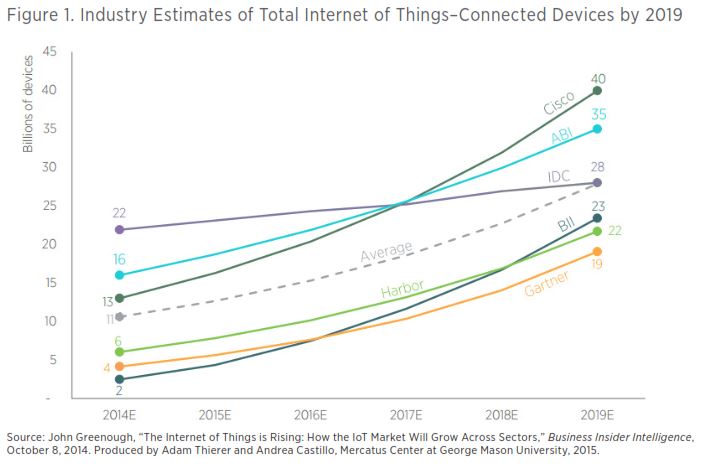On August 1, Sens. Mark Warner and Cory Gardner introduced the “Internet of Things Cybersecurity Improvement Act of 2017.” The goal of the legislation according to its sponsors is to establish “minimum security requirements for federal procurements of connected devices.” Pointing to the growing number of connected devices and their use in prior cyber-attacks, the sponsors aims to provide flexible requirements that limit the vulnerabilities of such networks. Most specifically the bill requires all new Internet of Things (IoT) devices to be patchable, free of known vulnerabilities, and rely on standard protocols. Overall the legislation attempts to increase and standardize baseline security of connected devices, while still allowing innovation in the field to remain relatively permissionless. As Ryan Hagemann[1] at the Niskanen Center states, the bill is generally perceived as a step in the right direction in promoting security while limiting the potential harms of regulation to the overall innovation in the Internet of Things.
Continue reading →
In theory, the Food & Drug Administration (FDA) exists to save lives and improve health outcomes. All too often, however, that goal is hindered by the agency’s highly bureaucratic, top-down, command-and-control orientation toward drug and medical device approval.
Today’s case in point involves families of children with diabetes, many of whom are increasingly frustrated with the FDA’s foot-dragging when it comes to approval of medical devices that could help their kids. Writing today in The Wall Street Journal, Kate Linebaugh discusses how “Tech-Savvy Families Use Home-Built Diabetes Device” to help their kids when FDA regulations limit the availability of commercial options. She documents how families of diabetic children are taking matters into their own hands and creating their own home-crafted insulin pumps, which can automatically dose the proper amount of proper amount of the hormone in response to their child’s blood-sugar levels. Families are building, calibrating, and troubleshooting these devices on their own. And the movement is growing. Linebaugh reports that:
More than 50 people have soldered, tinkered and written software to make such devices for themselves or their children. The systems—known in the industry as artificial pancreases or closed loop systems—have been studied for decades, but improvements to sensor technology for real-time glucose monitoring have made them possible.
The Food and Drug Administration has made approving such devices a priority and several companies are working on them. But the yearslong process of commercial development and regulatory approval is longer than many patients want, and some are technologically savvy enough to do it on their own.
Linebaugh notes that this particular home-built medical project (known as OpenAPS), was created by Dana Lewis, a 27-year-old with Type 1 diabetes in Seattle. Linebaugh says that: Continue reading →
[This is an excerpt from Chapter 6 of the forthcoming 2nd edition of my book, “Permissionless Innovation: The Continuing Case for Comprehensive Technological Freedom,” due out later this month. I was presenting on these issues at today’s New America Foundation “Cybersecurity for a New America” event, so I thought I would post this now. To learn more about the contrast between “permissionless innovation” and “precautionary principle” thinking, please consult the earlier edition of my book or see this blog post.]
Viruses, malware, spam, data breeches, and critical system intrusions are just some of the security-related concerns that often motivate precautionary thinking and policy proposals.[1] But as with privacy- and safety-related worries, the panicky rhetoric surrounding these issues is usually unfocused and counterproductive.
In today’s cybersecurity debates, for example, it is not uncommon to hear frequent allusions to the potential for a “digital Pearl Harbor,”[2] a “cyber cold war,”[3] or even a “cyber 9/11.”[4] These analogies are made even though these historical incidents resulted in death and destruction of a sort not comparable to attacks on digital networks. Others refer to “cyber bombs” or technological “time bombs,” even though no one can be “bombed” with binary code.[5] Michael McConnell, a former director of national intelligence, went so far as to say that this “threat is so intrusive, it’s so serious, it could literally suck the life’s blood out of this country.”[6]
Such outrageous statements reflect the frequent use of “threat inflation” rhetoric in debates about online security.[7] Threat inflation has been defined as “the attempt by elites to create concern for a threat that goes beyond the scope and urgency that a disinterested analysis would justify.”[8] Unfortunately, such bombastic rhetoric often conflates minor cybersecurity risks with major ones. For example, dramatic doomsday stories about hackers pushing planes out of the sky misdirects policymakers’ attention from the more immediate, but less gripping, risks of data extraction and foreign surveillance. Well-meaning skeptics might then conclude that our real cybersecurity risks are also not a problem. In the meantime, outdated legislation and inappropriate legal norms continue to impede beneficial defensive measures that could truly improve security. Continue reading →
The idea that the world needs further dumbing down was really the last thing on my mind. Yet this is exactly what Jay Stanley argues for in a recent post on Free Future, the ACLU tech blog.
Specifically, Stanley is concerned by the proliferation of “smart devices,” from smart homes to smart watches, and the enigmatic algorithms that power them. Exhibit A: The Volkswagen “smart control devices” designed to deliberately mis-measure diesel emissions. Far from an isolated case, Stanley extrapolates the Volkswagen scandal into a parable about the dangers of smart devices more generally, and calls for the recognition of “the virtue of dumbness”:
When we flip a coin, its dumbness is crucial. It doesn’t know that the visiting team is the massive underdog, that the captain’s sister just died of cancer, and that the coach is at risk of losing his job. It’s the coin’s very dumbness that makes everyone turn to it as a decider. … But imagine the referee has replaced it with a computer programmed to perform a virtual coin flip. There’s a reason we recoil at that idea. If we were ever to trust a computer with such a task, it would only be after a thorough examination of the computer’s code, mainly to find out whether the computer’s decision is based on “knowledge” of some kind, or whether it is blind as it should be.
While recoiling is a bit melodramatic, it’s clear from this that “dumbness” is not even the key issue at stake. What Stanley is really concerned about is biasedness or partiality (what he dubs “neutrality anxiety”), which is not unique to “dumb” devices like coins, nor is the opacity. A physical coin can be biased, a programmed coin can be fair, and at first glance the fairness of a physical coin is not really anymore obvious.
Yet this is the argument Stanley uses to justify his proposed requirement that all smart device code be open to the public for scrutiny going forward. Based on a knee-jerk commitment to transparency, he gives zero weight to the social benefit of allowing software creators a level of trade secrecy, especially as a potential substitute to patent and copyright protections. This is all the more ironic, given that Volkswagen used existing copyright law to hide its own malfeasance.
More importantly, the idea that the only way to check a virtual coin is to look at the source code is a serious non-sequitur. After all, in-use testing was how Volkswagen was actually caught in the end. What matters, in other words, is how the coin behaves in large and varied samples. In either the virtual or physical case, the best and least intrusive way to check a coin is to simply do thousands of flips. But what takes hours with a dumb coin takes a fraction of a second with a virtual coin. So I know which I prefer.
Continue reading →
 I wanted to draw your attention to yet another spectacular speech by Maureen K. Ohlhausen, a Commissioner with the Federal Trade Commission (FTC). I have written here before about Commissioner Ohlhausen’s outstanding speeches, but this latest one might be her best yet.
I wanted to draw your attention to yet another spectacular speech by Maureen K. Ohlhausen, a Commissioner with the Federal Trade Commission (FTC). I have written here before about Commissioner Ohlhausen’s outstanding speeches, but this latest one might be her best yet.
On Tuesday, Ohlhausen was speaking at U.S. Chamber of Commerce Foundation day-long event on “The Internet of Everything: Data, Networks and Opportunities.” The conference featured various keynote speakers and panels discussing, “the many ways that data and Internet connectiviting is changing the face of business and society.” (It was my honor to also be invited to deliver an address to the crowd that day.)
As with many of her other recent addresses, Commissioner Ohlhausen stressed why it is so important that policymakers “approach new technologies and new business models with regulatory humility.” Building on the work of the great Austrian economist F.A. Hayek, who won a Nobel prize in part for his work explaining the limits of our knowledge to plan societies and economies, Ohlhausen argues that: Continue reading →
The “Internet of Things” (IoT) is already growing at a breakneck pace and is expected to continue to accelerate rapidly. In a short new paper (“Projecting the Growth and Economic Impact of the Internet of Things“) that I’ve just released with my Mercatus Center colleague Andrea Castillo, we provide a brief explanation of IoT technologies before describing the current projections of the economic and technological impacts that IoT could have on society. In addition to creating massive gains for consumers, IoT is projected to provide dramatic improvements in manufacturing, health care, energy, transportation, retail services, government, and general economic growth. Take a look at our paper if you’re interested, and you might also want to check out my 118-page law review article, “The Internet of Things and Wearable Technology: Addressing Privacy and Security Concerns without Derailing Innovation” as well as my recent congressional testimony on the policy issues surrounding the IoT.)

A new bipartisan “sense of the Senate” resolution was introduced today calling for “a national strategy for the Internet of Things to promote economic growth and consumer empowerment.” [PDF is here.] The resolution was cosponsored by U.S. Senators Deb Fischer (R-Neb.), Cory A. Booker (D-N.J.), Kelly Ayotte (R-N.H.), and Brian Schatz (D-Hawaii), who are all members of the Senate Commerce Committee, which oversees these issues. Just last month, on February 11th, the full Commerce Committee held a hearing titled “The Connected World: Examining the Internet of Things,” which examined the policy issues surrounding this exciting new space.
[Update: The U.S. Senate unanimously approved the resolution on the evening of March 24th, 2015.]
The new Senate resolution begins by stressing the many current or potential benefits associate with the Internet of Things (IoT), which, it notes, “currently connects tens of billions of devices worldwide and has the potential to generate trillions of dollars in economic opportunity.” It continues on to note how average consumers will benefit because “increased connectivity can empower consumers in nearly every aspect of [our] daily lives, including in the fields of agriculture, education, energy, healthcare, public safety, security, and transportation, to name just a few.” And then the resolution also discussed the commercial benefits, noting, “businesses across our economy can simplify logistics, cut costs in supply chains, and pass savings on to consumers because of the Internet of Things and innovations derived from it.” More generally, the Senators argue “the United States should strive to be a world leader in smart cities and smart infrastructure to ensure its citizens and businesses, in both rural and urban parts of the country, have access to the safest and most resilient communities in the world.”
In light of those amazing potential benefits, the resolution continues on to argue that while “the United States is the world leader in developing the Internet of Things technology,” an even more focused and dedicated policy vision is needed to promote continued success. “[W]ith a national strategy guiding both public and private entities,” it argues, “the United States will continue to produce breakthrough technologies and lead the world in innovation.” Continue reading →
 Last Wednesday, it was my great pleasure to testify at a Senate Commerce Committee hearing entitled, “The Connected World: Examining the Internet of Things.” The hearing focused “on how devices… will be made smarter and more dynamic through Internet technologies. Government agencies like the Federal Trade Commission, however, are already considering possible changes to the law that could have the unintended consequence of slowing innovation.”
Last Wednesday, it was my great pleasure to testify at a Senate Commerce Committee hearing entitled, “The Connected World: Examining the Internet of Things.” The hearing focused “on how devices… will be made smarter and more dynamic through Internet technologies. Government agencies like the Federal Trade Commission, however, are already considering possible changes to the law that could have the unintended consequence of slowing innovation.”
But the session went well beyond the Internet of Things and became a much more wide-ranging discussion about how America can maintain its global leadership for the next-generation of Internet-enabled, data-driven innovation. On both sides of the aisle at last week’s hearing, one Senator after another made impassioned remarks about the enormous innovation opportunities that were out there. While doing so, they highlighted not just the opportunities emanating out of the IoT and wearable device space, but also many other areas, such as connected cars, commercial drones, and next-generation spectrum.
I was impressed by the energy and nonpartisan vision that the Senators brought to these issues, but I wanted to single out the passionate statement that Sen. Cory Booker (D-NJ) delivered when it came his turn to speak because he very eloquently articulated what’s at stake in the battle for global innovation supremacy in the modern economy. (Sen. Booker’s remarks were not published, but you can watch them starting at the 1:34:00 mark of the hearing video.) Continue reading →
This morning at 9:45, the Senate Committee on Commerce, Science, and Transportation is holding a full committee hearing entitled, “The Connected World: Examining the Internet of Things.” According to the Committee press release, the hearing “will focus on how devices — from home heating systems controlled by users online, to wearable devices that track health and activity with the help of Internet-based analytics — will be made smarter and more dynamic through Internet technologies. Government agencies like the Federal Trade Commission, however, are already considering possible changes to the law that could have the unintended consequence of slowing innovation.”
It is my pleasure to have been invited to testify at this hearing. I’ve long had an interest in the policy issues surrounding the Internet of Things. All my relevant research products can be found online here, including my latest law review article, “The Internet of Things and Wearable Technology Addressing Privacy and Security Concerns without Derailing Innovation.”
My testimony, which can be found on the Mercatus Center website here, begins by highlighting the three general conclusions of my work:
- First, the Internet of Things offers compelling benefits to consumers, companies, and our country’s national competitiveness that will only be achieved by adopting a flexible policy regime for this fast-moving space.
- Second, while there are formidable privacy and security challenges associated with the Internet of Things, top-down or one-size-fits-all regulation will limit innovative opportunities.
- Third, with those first two points in mind, we should seek alternative and less costly approaches to protecting privacy and security that rely on education, empowerment, and targeted enforcement of existing legal mechanisms. Long-term privacy and security protection requires a multifaceted approach incorporating many flexible solutions.
Continue reading →
Yesterday, the Federal Trade Commission (FTC) released its long-awaited report on “The Internet of Things: Privacy and Security in a Connected World.” The 55-page report is the result of a lengthy staff exploration of the issue, which kicked off with an FTC workshop on the issue that was held on November 19, 2013.
I’m still digesting all the details in the report, but I thought I’d offer a few quick thoughts on some of the major findings and recommendations from it. As I’ve noted here before, I’ve made the Internet of Things my top priority over the past year and have penned several essays about it here, as well as in a big new white paper (“The Internet of Things and Wearable Technology: Addressing Privacy and Security Concerns without Derailing Innovation”) that will be published in the Richmond Journal of Law & Technology shortly. (Also, here’s a compendium of most of what I’ve done on the issue thus far.)
I’ll begin with a few general thoughts on the FTC’s report and its overall approach to the Internet of Things and then discuss a few specific issues that I believe deserve attention. Continue reading →




 The Technology Liberation Front is the tech policy blog dedicated to keeping politicians' hands off the 'net and everything else related to technology.
The Technology Liberation Front is the tech policy blog dedicated to keeping politicians' hands off the 'net and everything else related to technology.